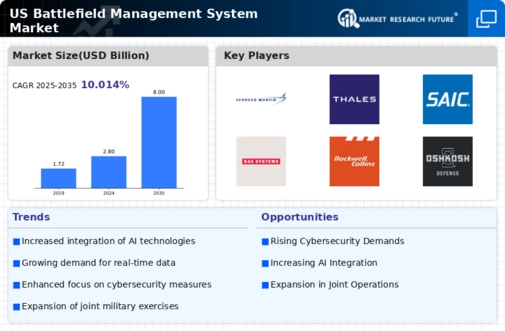Rising Geopolitical Tensions
The battlefield management-system market is being driven by rising geopolitical tensions that necessitate enhanced military readiness and capabilities. As nations face increasing threats, there is a pressing need for advanced systems that can provide comprehensive situational awareness and command and control capabilities. The US military is likely to increase its budget for defense technologies, with projections indicating an allocation of over $700 billion in 2025. This funding is expected to prioritize the development and procurement of advanced battlefield management systems, thereby stimulating market growth. The urgency to address emerging threats underscores the critical role of these systems in modern military operations.
Integration of Unmanned Systems
The battlefield management-system market is poised for growth due to the integration of unmanned systems, including drones and autonomous vehicles. These technologies enhance operational capabilities by providing real-time reconnaissance and intelligence gathering. The US military is increasingly adopting unmanned systems to complement traditional forces, which is expected to drive demand for advanced battlefield management systems that can effectively coordinate these assets. In 2025, the budget for unmanned systems is projected to exceed $10 billion, indicating a strong commitment to leveraging these technologies. This trend suggests a transformative impact on the battlefield management-system market as military forces seek to enhance their operational effectiveness.
Advancements in Communication Technologies
The battlefield management-system market is experiencing a surge due to advancements in communication technologies. Enhanced communication systems, such as secure satellite communications and advanced radio networks, are crucial for real-time data sharing among military units. These technologies facilitate improved situational awareness and decision-making capabilities on the battlefield. The integration of high-speed data links and secure communication protocols is expected to drive market growth. In 2025, the US military allocates approximately $15 billion to upgrade communication infrastructure, indicating a strong commitment to enhancing battlefield management systems. This investment reflects the increasing need for reliable communication in complex operational environments, thereby propelling the battlefield management-system market.
Increased Focus on Training and Simulation
The battlefield management-system market is benefiting from an increased focus on training and simulation technologies. As military operations become more complex, the need for effective training solutions is paramount. Advanced simulation systems enable military personnel to practice and refine their skills in realistic environments, enhancing their preparedness for actual combat scenarios. The US military is expected to allocate approximately $5 billion in 2025 for training and simulation initiatives, which will likely bolster the battlefield management-system market. This investment reflects a strategic approach to ensure that personnel are well-equipped to utilize advanced battlefield management systems effectively.
Growing Demand for Real-Time Data Analytics
The battlefield management-system market is significantly influenced by the growing demand for real-time data analytics. Military operations increasingly rely on data-driven decision-making, necessitating systems that can process and analyze vast amounts of information instantaneously. The ability to leverage data analytics enhances operational efficiency and effectiveness, allowing commanders to make informed decisions swiftly. In 2025, the US Department of Defense is projected to invest around $10 billion in data analytics technologies, underscoring the importance of real-time insights in modern warfare. This trend indicates a robust growth trajectory for the battlefield management-system market as military forces seek to optimize their operational capabilities.

















Leave a Comment